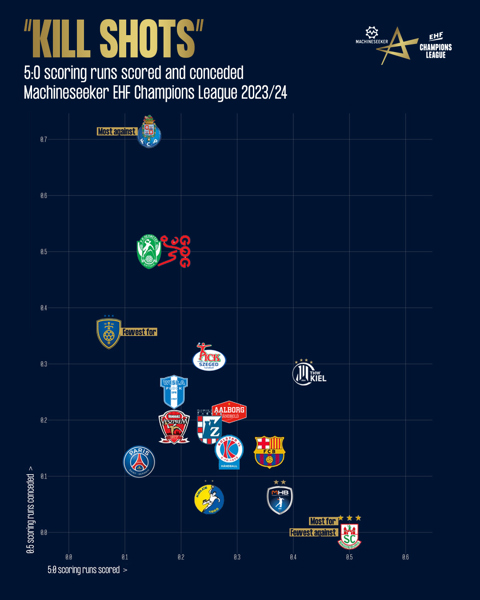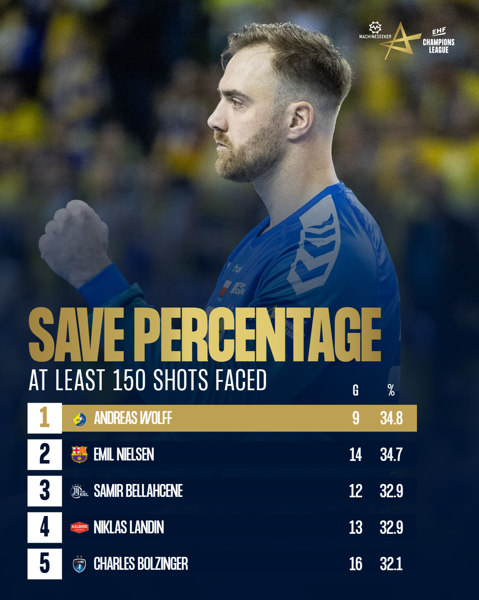At the beginning of Bennet Wiegert’s tenure at Magdeburg, his squad was infamous for their fast-paced style of handball. His team was regularly at the top of the pace (number of possessions per game) table in the Handball-Bundesliga. Today, Magdeburg are both in the Bundesliga as well as the Machineseeker EHF Champions League on average in pace.
Nevertheless, their offence is outstanding. With 30.7 goals per 50 possessions, they have the second-best attack of the competition. Only Telekom Veszprém HC are slightly better, with 31.4 goals. But the Germans are better at another type of running than any other team: scoring runs. A (scoring) run is defined as several goals scored by one team without the other team scoring or while the opposing team scores very few goals.
“Kill shots”
College basketball data analyst Evan Miyakawa introduced about a year ago, in his blog, a metric that measures the ability to go on scoring runs called “kill shots”. It’s defined as any time that a team scores ten or more unanswered points. Teams that make a lot of these runs are more likely to make up a deficit quickly and can also easily close the door on an opponent in a tight contest. Similarly, teams that limit their opponents’ “kill shots” are more likely to maintain a lead rather than allow another team back into the game.
The equivalent of a 10:0 run in basketball is a 5:0 run in handball. Comparing the following stats of the "kill shots" from all Machineseeker EHF Champions League games since the beginning of the 2021/22 season gives similar results to those that Miyakawa describes in his blog:
- A team with at least one “kill shot” wins 78.8 per cent of the time.
- A team with more “kill shots” than the opponent wins 78.3 per cent of the time.
- A team with two “kill shots” in a game wins 100 per cent of the time (20 out of 20).
- A team with a 7:0 run wins 87.5 per cent of the time (17 wins and two draws out of 19).
SC Magdeburg are twice at the top of the “kill shots”. They are the team that had the most this season and the team that allowed the fewest. In every second game, they have gone on such a big run (no other team has had so many in the last two seasons) while they are the only team that conceded not even one. They are always likely to make a big scoring run and thus decide a game for themselves, which also allowed them to win their group.

The team with the second most “kill shots” per game is the other group winner THW Kiel with 0.43 per game. Their matches are overall streakier than Magdeburg’s, as they also concede 0.29 per game, the most among the teams still in the competition. Their quarter-final opponents Montpellier HB have the second-highest difference of “kill shots” scored and conceded after SCM with 0.31 (0.38 scored and 0.06 conceded).
Porto had the streakiest games, with 0.86 overall “kill shots”. However, they only scored 0.14 themselves and conceded the most, with 0.71, and thus have the most negative “kill shot” difference. When they had the lead, you could never trust them to hold on.
Paris Saint-Germain Handball are on the other side of the spectrum, as their games are the least streaky. They scored the second-fewest 5:0 runs (fewest amongst the teams still in the competition) but also conceded the fourth-fewest. The situation at PSG has also been very similar in the last two years, so they just don't seem to be a streaky team.
What that means for Wednesday’s MOTW
Interestingly, this is a new development for the Magdeburg team. Last season, when they won the Machineseeker EHF Champions League, they were not so streaky. They had just 0.22 “kill shots” per game, while they conceded 0.11. Their finals opponents, Industria Kielce, even had a negative “kill shot” difference, as they scored just 0.17 5:0 runs per game but conceded 0.22 in the 2022/23 season.
SCM will also face Kielce in Wednesday’s Match of the Week in the first leg of the quarter-finals. In contrast to the German side, Kielce don’t count much on big runs this season either. Among the teams still in the competition, just PSG and Telekom Veszprém HC had fewer “kill shots” than Kielce’s 0.25 this season. However, Talant Dujshebaev’s team is the second-best at avoiding them, with just 0.06 conceded per game.
Preventing these runs will be difficult enough for the Polish team, as the statistics of the defending champions are better almost everywhere. Offensively, Magdeburg rank second with 30.7 goals per 50 possessions, while Kielce rank fourth with 29.4. The only offensive statistic where the team from the Holy Cross Mountains is better are second chances. After 21.4 per cent of their misses, they remain in possession, while it’s only 18.4 per cent for SCM.
In defence, Magdeburg are seventh with 26.9 goals conceded per 50 possessions, while Kielce are just tenth, conceding 27.9. Here, the Polish side are slightly better at forcing turnovers (8.5 per 50 possessions versus 8.3), seven-meter penalty shots caused (3.6 per 50 possessions versus 3.7) and blocking shots (4.1 per cent of the field attempts versus 3.8 per cent).
Using these statistics that are adjusted for possessions played is significantly more meaningful than just the raw number of goals (conceded), because it makes the teams actually comparable since the raw number of goals is not only influenced by efficiency, but also by the number of possessions (whether a team and their opponents play rather fast or slow). Since a game has roughly 50 possessions on average (53.1 this season), the values here are calculated on 50 possessions so that they roughly reflect those of a game.
The most significant, however, could be the goalkeepers. Kielce (30.2 per cent, fifth) already rank slightly ahead of Magdeburg (29.8 per cent, eighth). However, Kielce’s number one goalkeeper, Andreas Wolff, who leads the Machineseeker EHF Champions League in save percentage, with 34.8 per cent so far, only played nine matches this season. In contrast, Magdeburg’s number one player Nikola Portner, who ranked seventh with 31.3 per cent, will not play in the quarter-final.

So, besides the scoring runs, the goalkeeper's performance could be the decisive factor. In addition, we must consider that they did not play in the same groups and the numbers are therefore not 100 per cent comparable, but the trend is clear that Magdeburg are the favorites.
However, as both teams are among the six slowest teams in terms of pace and length of possessions, not that many runs can be expected apart from scoring runs.
More from data analyst Julian Rux can be found at Handballytics.de. There you can read his latest articles, in which he analyses all kinds of handball topics from new, data-based perspectives. You can also find him on Instagram, Facebook, X/Twitter, Threads and WhatsApp Channels.
Main photo © Eroll Popova








